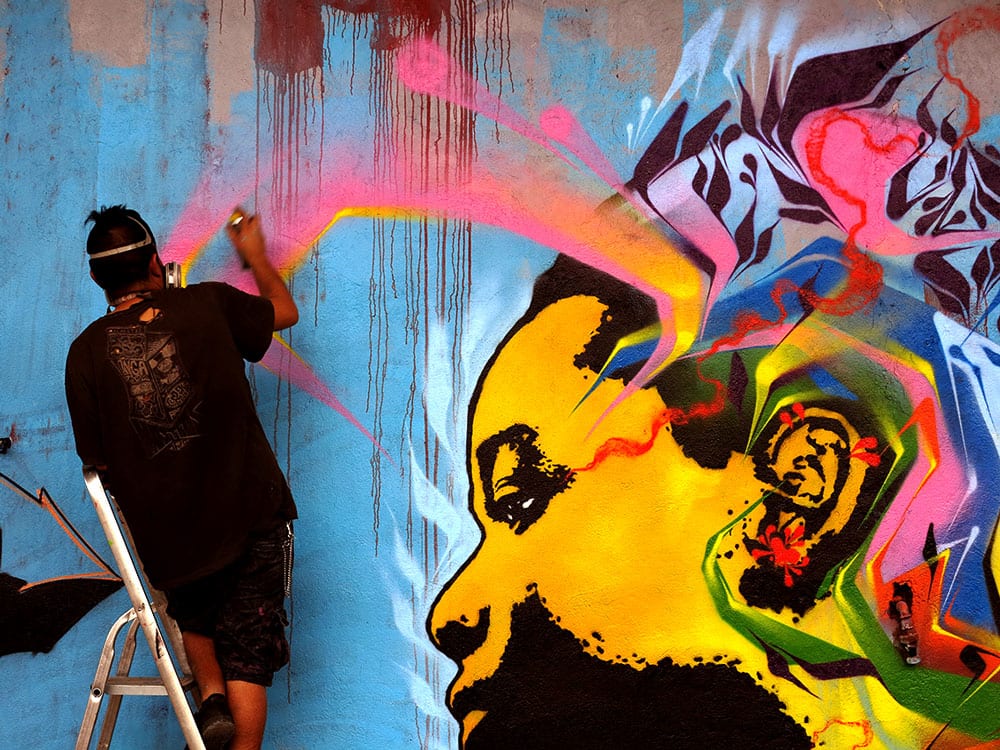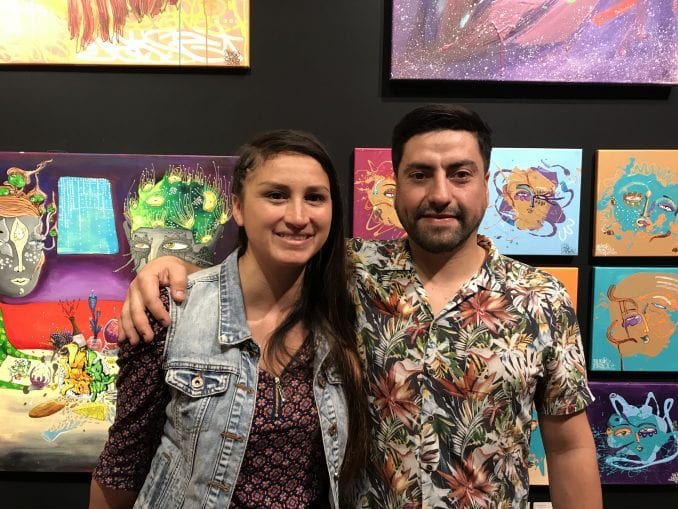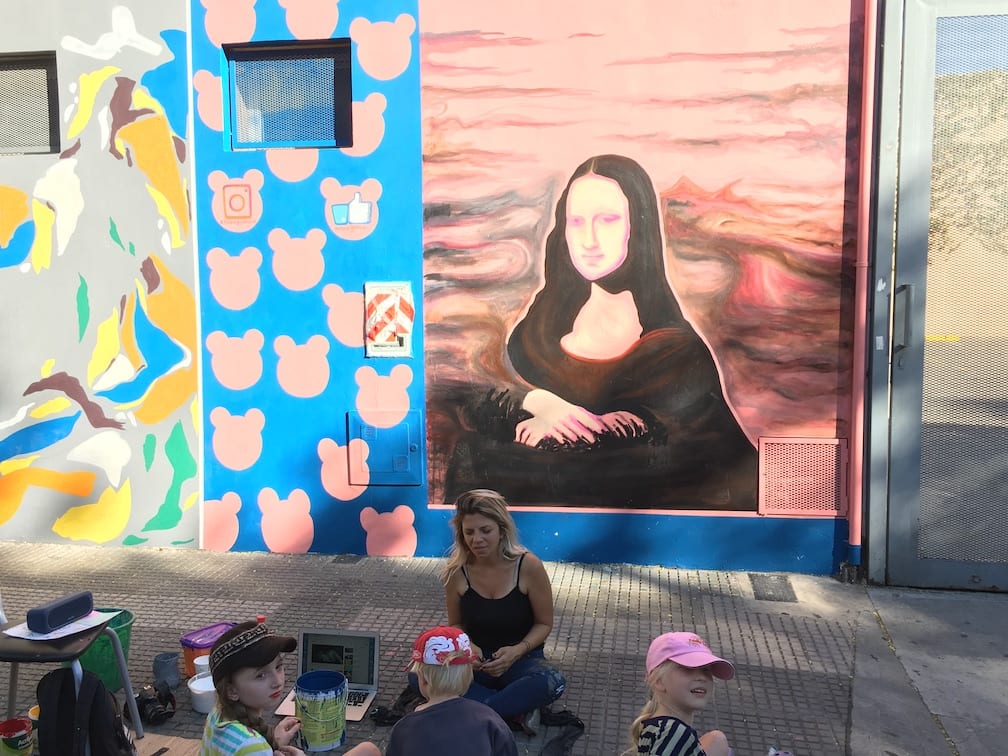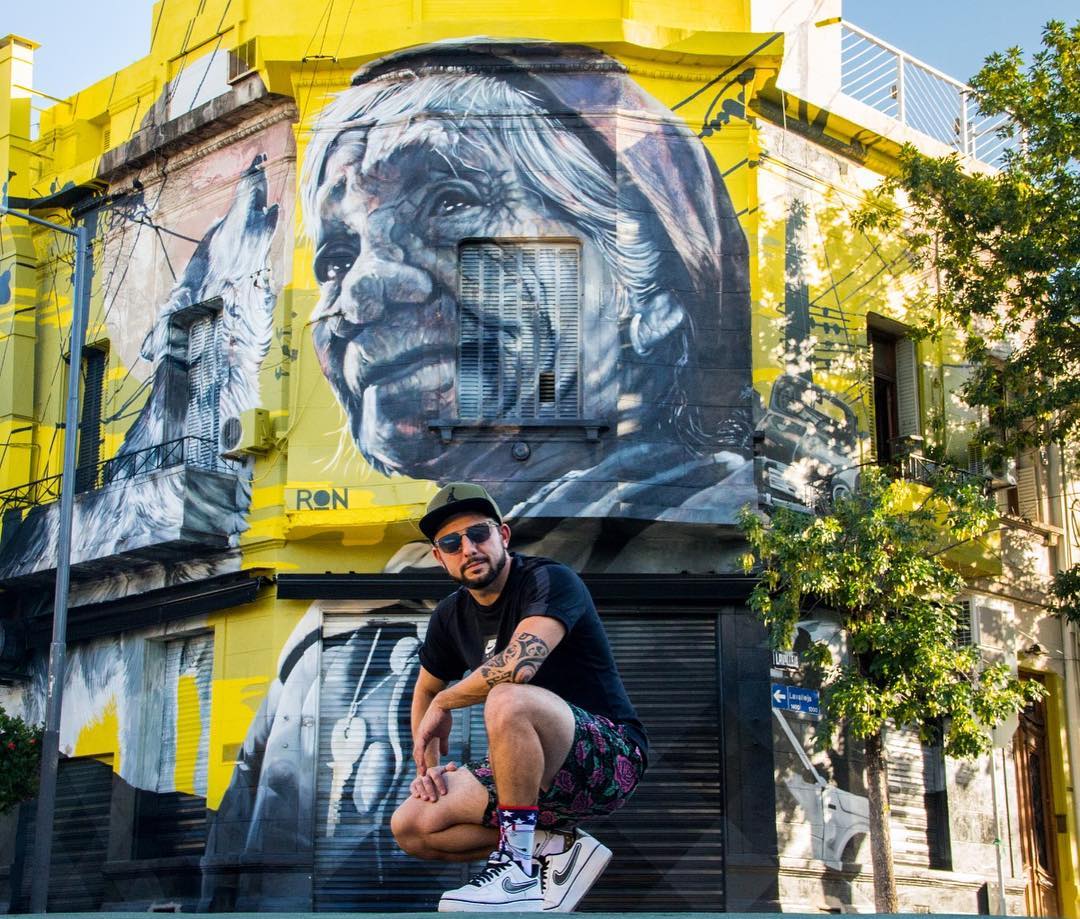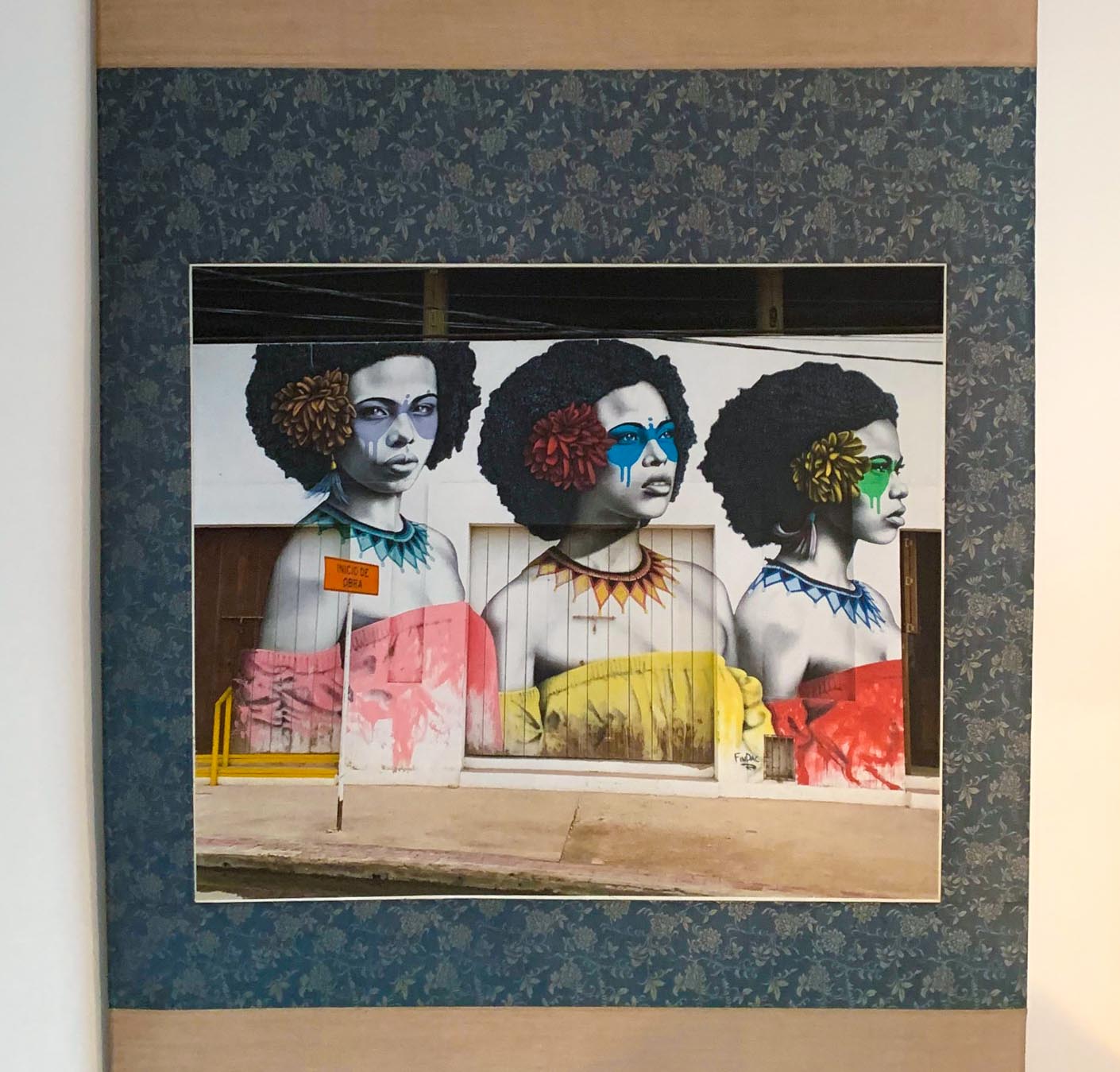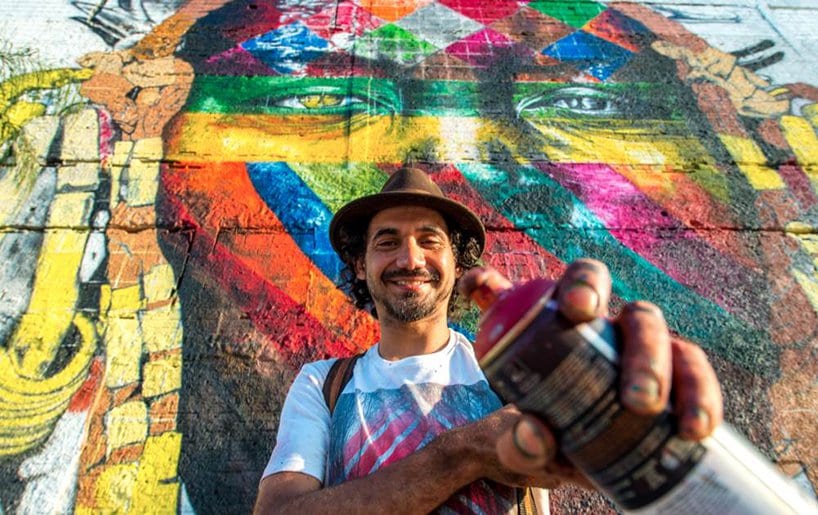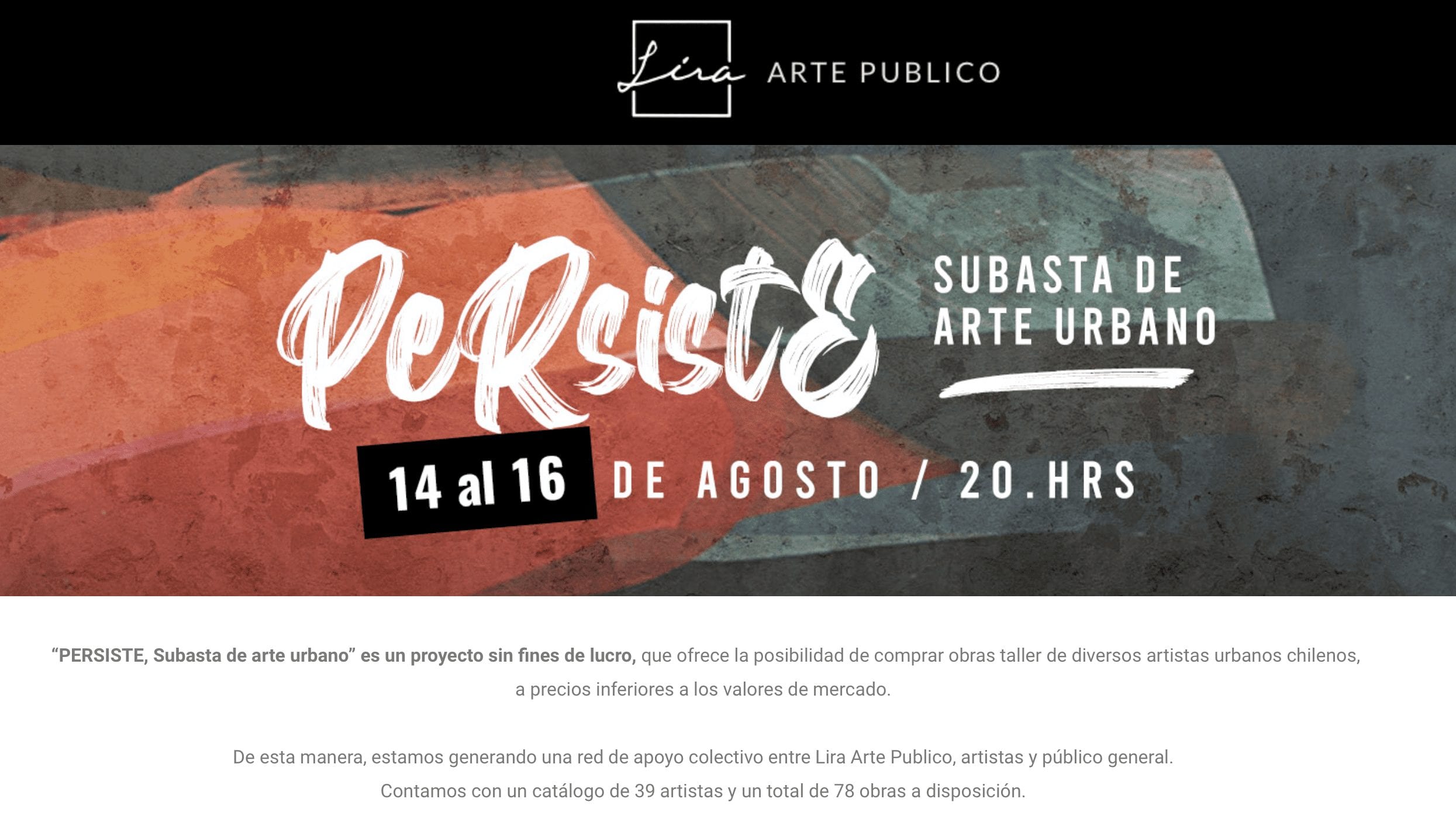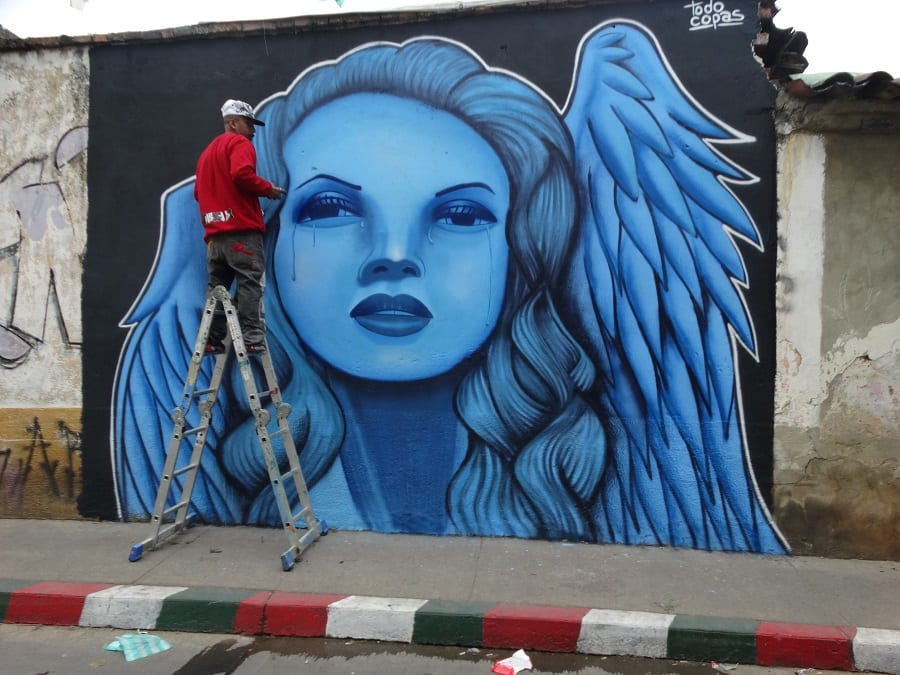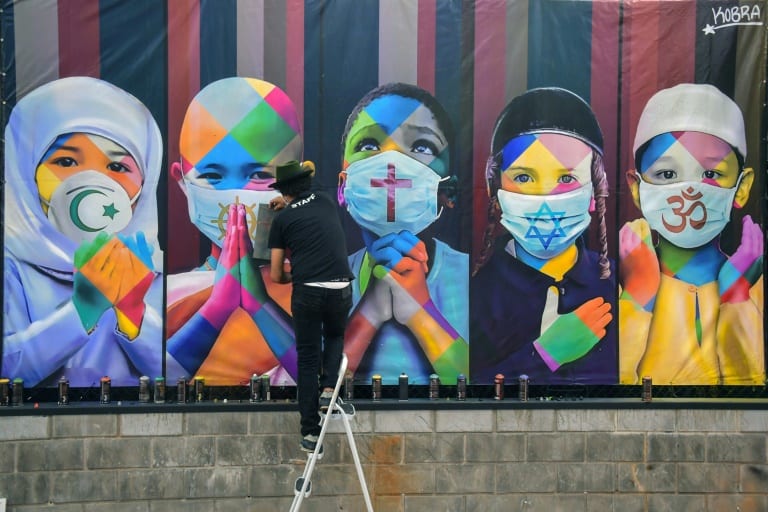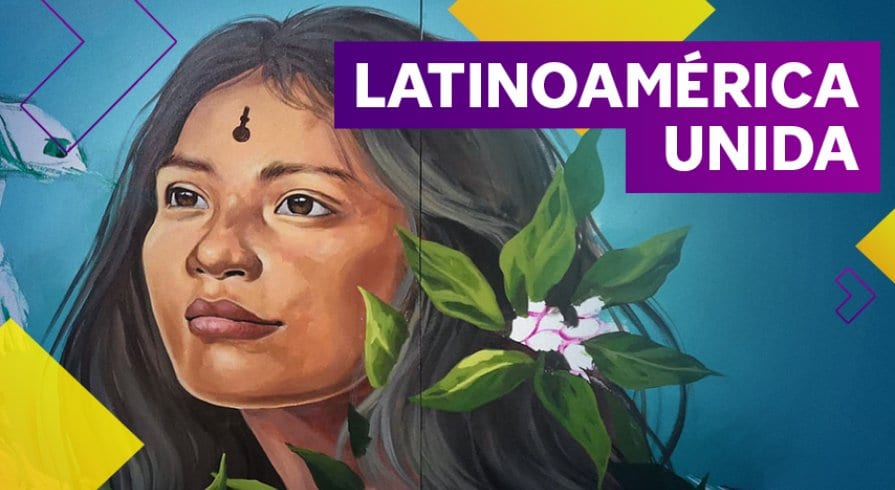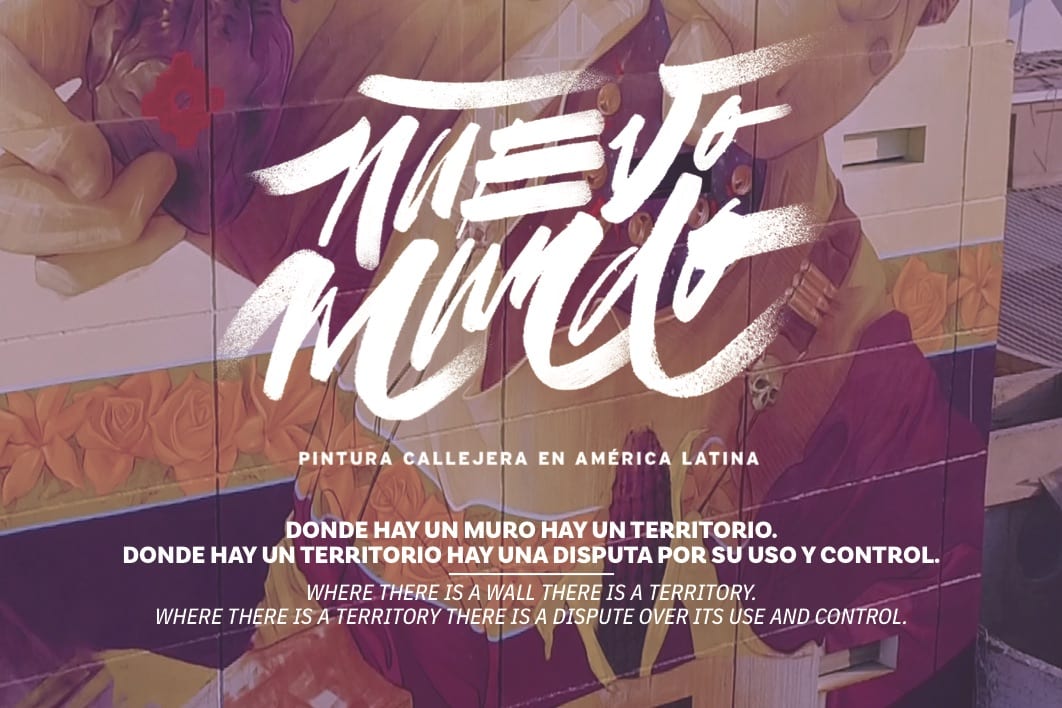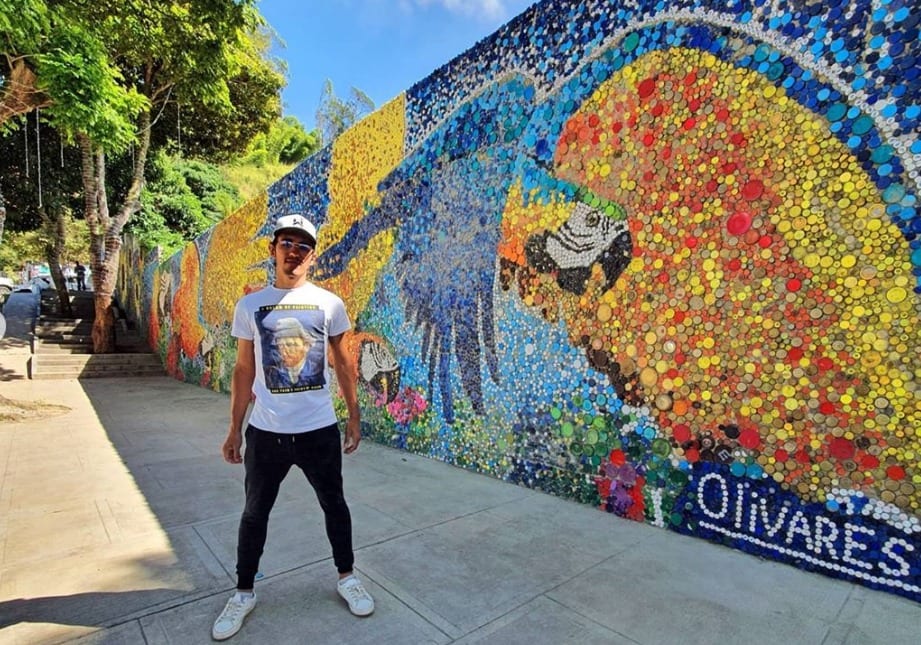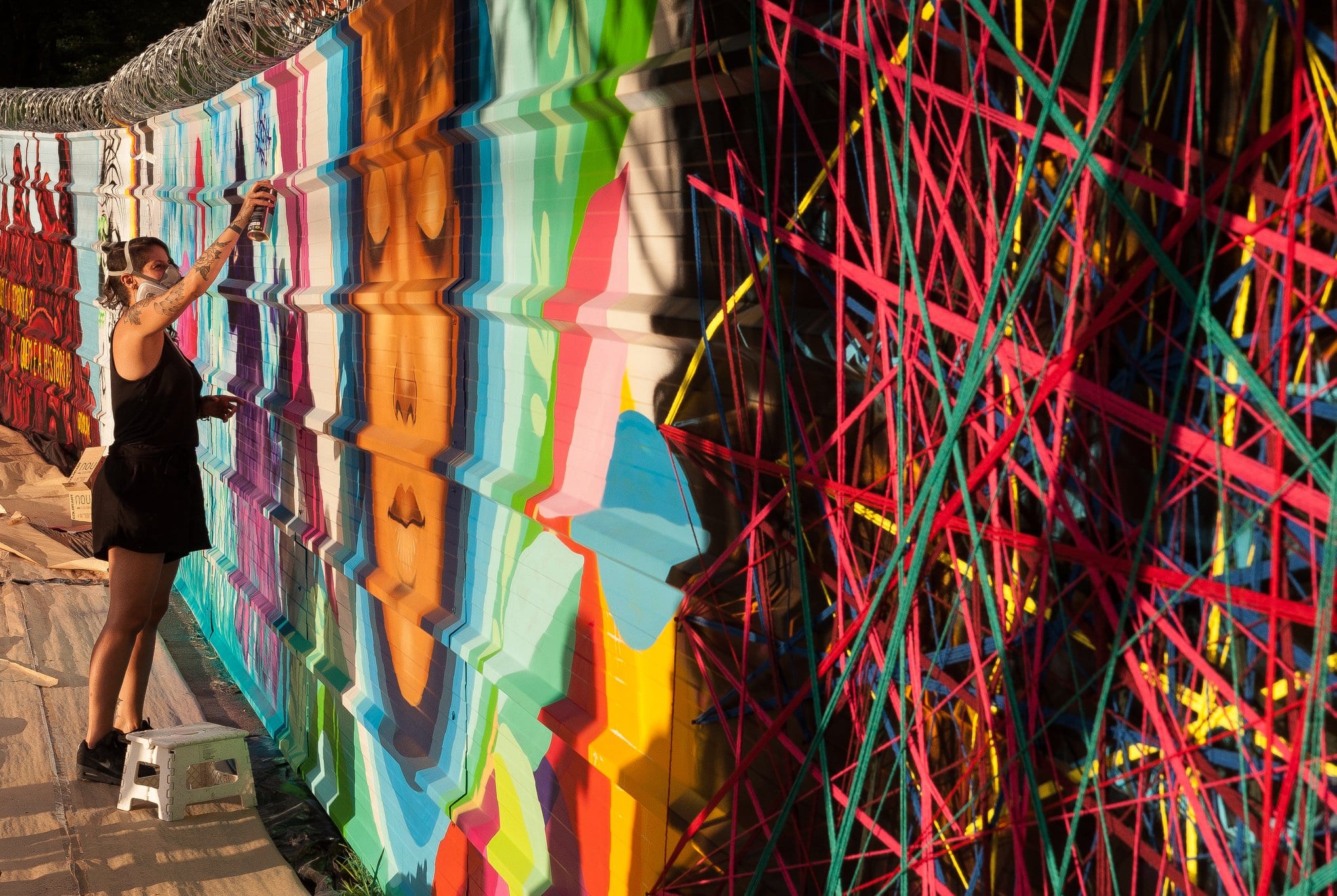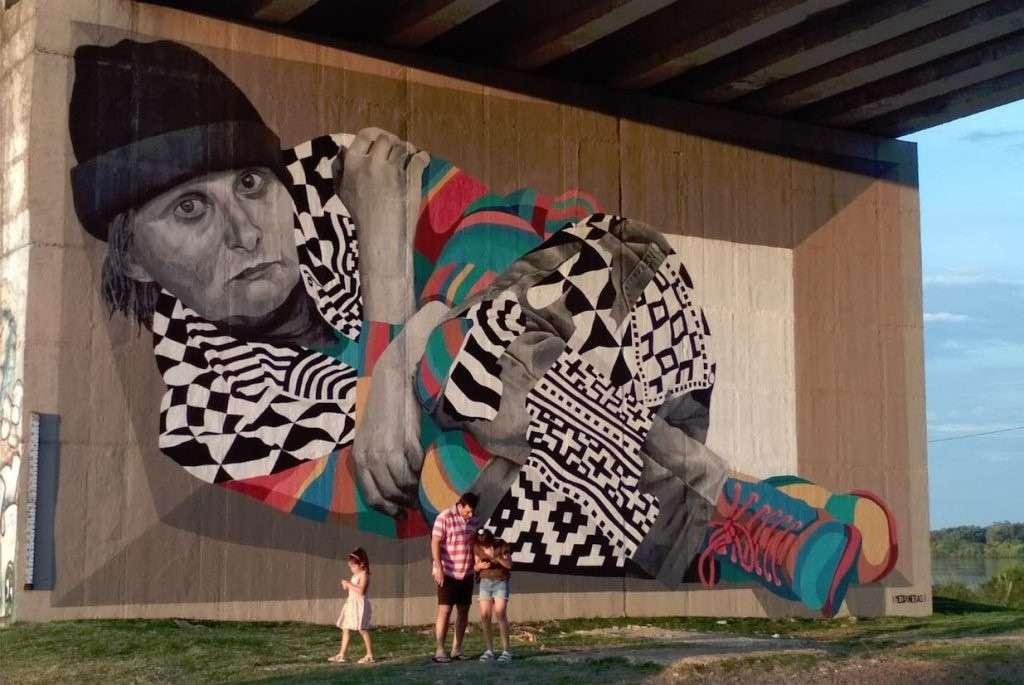(Stinkfish)
Based on the sheer volume and size of the murals he paints I’m sure lots of people out there know the identity of this anonymous street artist. At the time of writing this article however, we still have no idea who this prolific painter is. As I was traveling around South America there were a few artist’s work I would see over and over again, unlike other painters who might just paint in the city they live in, pieces by Stinkfish can be seen in just about every large urban area of SudAmerica. Originally from Mexico, he moved to Bogota at a young age with his parents and eventually became interested in making street art, first by painting stencils around 2000 and then a few years later starting to work on larger, more complex pieces. Today his style is very recognizable and he has huge murals not just in the city where he continues to live and work but everywhere from Rio to Santiago to Buenos Aires to Lima. Though he paints a lot of different themes, his most common works are based on pictures of people he has actually seen or met. First he takes these pictures and then paints their likeness adding technicolor elements including streams of colorful beads shooting from their eyes, tiaras of light around their heads, and explosions of auras emitting from their bodies or from behind their ears. Once you have seen a painting by Stinkfish you will instantly recognize his work everywhere you see it. In an anonymous interview he did a few years ago with another well-known street artist, he had this to say about his work:
“The most important and clearest messages in my street art are the ideas of independence, anonymity, freedom and illegality. For me that´s the important thing in all this work and community.
Regarding the portraits I do, the idea is to speak about the importance of common people, like you, like me, like everyone in the common life, far away from the false world of the “famous” and “important” people of this system.”
Hopefully we get a chance to meet up with or interview him one of these days to find out more about his ideas and his message.
Sammy & Cynthia (Un Kolor Distinto)
Over 30 years ago in the ocean-side epicenter of Chile’s burgeoning street-art movement, a couple of kids took paint cans in hand and started feverishly adding to the color explosion that was enveloping the city. At the time, many residents considered the street art and graffiti to be a nuisance and painters were perpetually having to evade the police. Today however, the situation is quite different.
Now with thousands of high-quality artworks and murals in every corner of the city, Valparaiso has become an international destination and tourists and fans of street art from around the world swarm to the city, adding a valuable source of revenue for residents apart from the the traditional jobs of working in the port or for the fishing industry. Over time Sammy and Cynthia took on larger challenges and their surreal but distinctive male and female characters grew to even greater proportions. Then around the year 2000 the city government started sponsoring them and they took on commissions to paint a number of tall apartment buildings around the city. Today, in a city full of art, they remain the most recognized and well-represented muralists despite the brimming talent the city continues to attract.
Inti Castro (INTI)
There are a lot of different paths that can bring someone to being a world-class street artist, some arrive there out of desperation, wanting to escape a situation or spread a political message; meanwhile others may be chasing fame and fortune or just trying to express a creative drive that keeps them painting. In the case of INTI, some of this may have played a part, however, he just seems to be one of those people who were made for it. Born in one of the street art capitals of the world (Valparaiso, Chile) into a family dedicated to the arts and music, it is no surprise that he would naturally gravitate to this kind of pastime. What is surprising is the degree to which he has excelled and the level to which he has helped raise his art-form. Painting intricate and large murals packed with symbolism and mythic figures, seemingly from a parallel world, the level of attention to detail in his artwork clearly reflects his formal training as a professional painter.
His success eventually lead him out of Chile, though his roots there remain strong and his Latin American influence, particularly influences related to indigenous peoples, continue to be an important component of his ongoing artistic expression. Today he resides mainly in Barcelona Spain where he continues painting large murals and also sells gallery pieces.
Victoria Ferrerya (PintaArgentina)
I first met Victoria while wandering around Palermo district in Buenos Aires back in 2018. At that time she was already painting large murals, the most well-known of which was a picture of Frida Kahlo she had done on the second floor of her house. Very active in the community, apart from painting she also spends a lot of her time coordinating with other artists and–as can be seen in this picture I took of her in 2018–she is really devoted to teaching and inspiring the next generation. When I made my second stop back to Buenos Aires in late 2019 I was surprised to see that she had completed a giant mural in a neighborhood park that really blew me away. We wish the best for her and hope to meet up again in the future sometime. If you want to know what she is up to and see more of her work you can follow her on Instagram at: @PintaArgentinaok and on FaceBook at www.facebook.com/pinta.argentina
Martin Ron (Ron Muralist)
One of the most recognized muralists in all of South America, Martin Ron has continued to produce massive and intricate compositions at an astounding rate. A native of Buenos Aires, many of his early paintings remain today on the streets of Tres de Febrero and many newer works can be found around the city center. His style could be described as often photorealistic with elements of surrealism, hyper-realism, and a kind of idealized nostalgia. We here at SASAfund are a big fan of his work and hope to bring you more details in the future!
An Argentine muralist dedicated to art since childhood, he studied Management in Art and Culture at the University Tres de Febrero and later worked as a teacher there. Preferring large-scale compositions, he defies heights and perfects his realistic style with playful fantasy themes that charm the unsuspecting passerby who is lucky enough to run across some of his gigantic pieces of art.
A native of the Province of Buenos Aires, the walls of the Tres de Febrero location were the perfect canvas to make some of his masterpieces, and, because borders were never a problem for him, his art spread from various neighborhoods in the City of Buenos Aires to other provinces of Argentina, and countries such as England, Spain, Estonia, USA, and Malaysia, just to name a few.
It all started when, as a teenager, he painted the walls of his room and later those of his friends. The next invitation came from his school, and a few years later he was already working as a public agent; an artistic director of the Urban Beautification Program in the Tres de Febrero for five years.
The works of Martín Ron stand out for their saturated color palette, their hyper-realistic images but with outlandish themes, and, of course, their large size. We can characterize Ron as a surrealist artist and it seems like street art has allowed him to experiment with new things, giving rise to changes in technique, lines, and themes while being on the search for new colors, textures, dimensions, and sizes in his works. Martín tends to paint elements of real life brushed with decidedly surreal nuances; and, because he draws on things and events that cross his plane of existence, his pieces maintain a high degree of relevance and relatability to everyone.
The themes of his works are as varied as his painting style, but he tends to include great characters from popular Argentine life ( Isabel “La Coca” Sarli, Carlos Tévez, etc) and an emphasis on nature and the incidence of human beings in its degradation and possible salvation.
Generally listed as one of the ten best muralists in the world, Martín Ron has built his own name full of colors and life but it does not stop him from continuing to break borders. You can check out his amazing art on his Instagram account at @ronmuralist, where he regularly posts new content.
The Hanging Scroll Project
Over the course of two years driving long stretches of highway between major cities in search of new art to photograph, I had a lot of time to think. This was especially true because early on in my travels the antenna on my SUV broke off one day while off-roading, leaving me with not even the option of listening to local radio stations. Sometimes I would be driving 10, 12, 14 hours in one day, and the place I would end up looked almost identical to the place I started off from in the morning. Breathtaking scenery to be sure, but with no major landmarks or scenery breaks, or music to distract the mind, thoughts tended to drift, and I often found myself contemplating what I was going to do with all of these images once I was “finished” with the epic project I had somehow conned myself into undertaking. It was through this kind of daily meditation that I eventually came up with the idea of starting the SASA fund site. In the same way, I used this time to refine the concepts for the book―still a work in progress―and imagined interesting ways to combine the Japanese art and aesthetics of my profession with these captivating images that were so much in contrast with the subtle and refined Japanese styles I was used to.
Being an art dealer in Japan I often come across beautiful antique hanging scrolls with intricate silk brocades, some of which, due to their great age, display paintings that have not stood the test of time as well as their backing. Exquisitely beautiful things that are considered to have very little value in Japan because they are thought to be unsalvageable, with the cost of meticulously taking them apart and refurbishing them being too great in most cases. Meanwhile, the artwork that I was discovering on the streets of South American cities, though captivating to me, seemed not always to be appreciated by the people living there. Although everyone in the know would agree there are a lot of exceptionally talented artists in every corner of South America producing world-class murals, it is just as true there is also a lot of crap to sift through, if we are being completely honest. So the idea I kept coming back to again-and-again was taking these under-appreciated relics from Japan and seeing if I could adorn them with these under-appreciated artworks I was documenting in South America. A clash not only of cultural forms, but also (I hoped) something that might trigger a total reevaluation and reappraisal of each cultural artifact in relation to the other. Discarded cultural remnants, slowly decaying into oblivion, that, when combined in the right way and with the right sensitivity, might bring new life to both.
So, that is what I have been working on since coming back to Japan in April of 2020, making high quality prints on Japanese washi and having traditional craftsmen mount them on beautiful old silk scrolls, hopefully one day to find their way to the walls of various galleries around the world for exhibition. We will be adding images of these pieces to a gallery here soon so if you would like to support us by purchasing one, know that proceeds go mainly to continuing our activities documenting street art, to a book that we hope to have out in the next year or two, and to supporting artists across South America. Also, if there are any images from the gallery that you would like us to print on washi or mount on a scroll you can contact us and we can discuss the details. Thanks again for all your support ~
Eduardo Kobra (Kobra)
Early in 2019 I made my way to Sao Paulo and started going around the city looking for new street art to photograph. Within days it became clear to me that this guy named Kobra was a very serious street artist (I never really researched before arriving in a new place because I always liked to be surprised by what I found). His massive kaleidoscopic murals could be found everywhere and it was unbelievable to me how one person could create so many paintings on such a grand scale. Later when I went to Rio I saw the murals he had done for the 2016 Olympics titled “Ethnic Groups” (the largest in the world at the time) and learned that these days Kobra has an entire crew to support the giant creations he continues to imagine and spray-paint into existence. Today you can find his work not only in Brazil but on buildings in major cities across the globe and even people who are not so much into street art often recognize his name.
Born in 1975 in a suburb of São Paulo, over the course of his 30 year career he has conquered the street art scene on a global scale and has left his mark in over 40 countries on five continents. The son of a housewife and an upholsterer, Eduardo Kobra grew up in a community on the outskirts of São Paulo. Detained about 3 times for painting with spray paint in the streets, today he is one of the most acclaimed street artists in the history of contemporary art.
It is interesting to know that Eduardo Kobra started at the age of 17 with “Pichação”, a form of street art characterized by particular typography painted on the facades of high buildings. He also has a fondness for studying the most representative images of humanity’s past, which, is the mainstay of many of his works.
While Eduardo Kobra’s early works were confined to Brazil, in 2011, he created his first mural outside his country when France invited him to paint a wall about immigration in a Lyon neighborhood, leading him to eventually paint murals in a number of countries around the world. In 2016, Eduardo made headlines for creating his illustrious mural “Las Etnias” (The Ethnicities) that covered Olympic Boulevard at the 2016 Rio Olympics. “Las Etnias” earned Kobra and his team the record for the largest spray paint mural by a team. A year later, Kobra and his group surpassed their previous record with their gigantic work at Cacua Show Headquarters (a chocolate company located in São Paulo), this time, painting an ode to cocoa harvest and its relation with the Amazon.
Eduardo Kobra presents spectacular works playing with light and shadow. The results are a series of three-dimensional mural works that allow the public to interact with it. Often contrasting a romantic air and nostalgic atmosphere with the characteristic agitation of big cities like São Paulo.
Despite not having been trained in any art school, Eduardo Kobra manages to achieve astonishing techniques and perfection in his works. Full of color and joy, he likes to represent people on the streets where he unmasks social problems as well as pop culture myths. Brazilian artist Eduardo Kobra uses bright colors and bold lines while staying true to a kaleidoscope theme throughout most of his art.
Additionally, Eduardo’s ability to achieve photorealism while maintaining his playful color theme is fantastic. Specifically, his use of brushes, airbrushes, and spray cans serve as a means of bringing notable figures from the past to life, emphasizing their true nature, dignity, and beauty. You can’t help but feel nostalgic as you look at his creations, going back to a time when such people existed while Kobra adapts them to the modern visuals that we are so used to recently.
You can follow Eduardo Kobra’s newest works on his Instagram profile https://www.instagram.com/kobrastreetart/ and on Facebook https://www.facebook.com/kobrastreetart.
"Persiste" the First non-Profit Street Art Auction in Chile Successfully Completed
The Chilean street art gallery Lira Arte Público and a group of artists organized a charity auction called “Persiste” with the participation of well-known talents such as INTI, Alejandro “Mono” González, Cekis, Caiozzama, Anis, Mical, Alme and Stfi. The event took place via online streaming and offered several workshop pieces for sale―with a total of 78 works by a variety of 39 emerging and established artists―featuring both local names and artists from abroad.
The auction system used an online catalog that offered participants a chance to preview pieces before buying. Bidding began on Friday the 14th at 8:00 p.m. and finished on Sunday, August the 16th at the same time. All of this took place on the Lira Arte Público website for the event: persiste.liraartepublico.com. At the completion of the auction on the 16th, a few special events were held including Q&A with artists from the catalog, addressing comments left by the community on the event Instagram account: @persiste_subasta and @liraartepublico
The organizers stressed that the event was non-profit and that neither the gallery nor the artists received a commission on sold pieces. Instead, in a show of solidarity with the community, all proceeds went to support art and culture related areas that had been severely impacted as a result of the ongoing pandemic.
Perú and Colombia Celebrate Their Close Ties Through Urban Art Talks
On July 21st, the muralists Yohn Smith Sierra and Roberto Peremese will participate in a lecture titled “Conversations About Urban Art,” where they will discuss how their projects have contributed to the transformation of cities like Lima and Bogotá.
Smith and Peremese plan to talk about the purpose of their urban interventions and how their projects have influenced the transformation and redefinition of the center of cities such as Bogotá and Lima. Other topics to be discussed are the ideal conditions for art interventions in large citiesl; the importance of modern movements such as hip hop, graffiti, and muralism; and how street art has managed to make inroads into traditional cultural sectors.
The interview is part of a series of events related to “The Peru Week in Colombia,” a festivity carried out by the embassy of Peru in Bogota that includes cultural, commercial, and gastronomic events, as well as activities to promote tourism. The festival will run until July 24th and offers an opportunity for Colombians to get to know more about the neighboring nation of Perú.
The celebration is an expression of the long friendship and cultural ties between Peru and Colombia, where the main topic will be about cultural construction in the center of these two countries.
The Fourth NUMU Festival Takes Place in Ecuador Despite Obstacles
NUMU is an urban art festival that has been taking place in the city of Ibarra in the north of Ecuador since 2017. Its name comes from the words “nuevo mural” or “new mural” because every year they choose a new neighborhood in the city to hold this event. An independent and self-managed project, in the past it has met with multiple setbacks due to lack of resources, logistics, national protests, and this time in 2020, due to a worldwide pandemic.
We here at SASA first discovered NUMU in 2019 entirely by accident. While traveling back south from Colombia, we got caught up for a few days in the riots that had completely shut down the city (a protest against labor laws and a repealing of a fuel subsidy that affected agrarian communities greatly). While trying to make our way around all of the blocked roads, burning tires, and crowds of protesters, we wandered into one of the neighborhoods that had been recently painted by NUMU. Without the protests we likely never would have discovered these excellent pieces, many of which you can see in our gallery page on Ecuador.
As we later learned, Ibarra was once a city with no modern murals and with a conservative agrarian population who—before this festival began—largely believed that muralism had to be done in a certain way and that it had to reflect conservative rural values. Now the city has become the headquarter of this project that takes it as its mission to liven up the neighborhoods by adding a splash of color and creativity.
Though the festival is now more popular than ever before, not just among visiting artists, but also with the local population; similar to in years past they still have a lot of challenges to overcome. This year a lack of funding almost stopped the project in its tracks; but then the organizers decided to go ahead with fundraising and collecting donations. Eventually, with the help of the community, the artists themselves, and partly thanks to the reputation NUMU had built for themselves through past events, it was possible to make things happen. So despite all the setbacks, (even more than in past years) the festival took place over three days at the end of July and the result was that the streets of Simón Bolívar neighborhood were filled with freshly painted murals by both local and International talent such as Pino Supay, Azpeger, Paint, Rayz, Diegumberrto, Anadnum, and Andrés Cuatín.
The NUMU festival is an example of a commitment to self-management and community power and its resiliency stems from the passion of its organizers and participants who find ways to join together to beat the odds. The worldwide pandemic further complicated the situation this year, however, at the same time managed to create more of a need for self-expression. As a result, this year turned out to be one of the most successful festivals yet. We are hoping to get back to Ecuador when the situation improves so we can document some of the results.
Brazilian Street Artist Kobra Paints Mural Calling for Unity in Time of Pandemic
Anyone who follows street art is sure to have come across the name Kobra at some point in time. Originally from Sao Paulo, he is known for painting large kaleidoscopic photorealistic images, often depicting famous people or recognizable themes. A superstar in his own country, in recent years he has traveled abroad frequently, creating large compositions on buildings in major cities across the globe in his iconic style. Recently though, with Brazil being particularly hard-hit by this world pandemic, the places where he works, creates, and finds inspiration are increasingly off-limits as public lockdowns prohibit people from being outside in the streets for much of the day.
Cut off from his ability to work on large murals, Kobra decided to paint a small mural indoors that he calls “Coexistence.” The piece depicts children from all 5 of the world’s major religions joined together in prayer to overcome the suffering brought about by this worldwide plague. The message is one of unity, urging people to put aside their differences and to focus on our common humanity. His hope is that once restrictions are lifted and the situation seems safe again, he will be able to create a full-size rendition somewhere in the world.
Wanting to ease the situation for people in his country, Kobra also set up a charity to feed the homeless by auctioning off prints of his mural to help raise funds for basic meals for people on the street who must find it especially difficult during these times to survive in such harsh conditions
South American Muralists Come Together in the 5th Edition of the Amazonarte Festival
Even in these times of quarantine, artists still manage to find ways to gather to practice their craft. In addition to working on their creations within health guidelines, they have also decided to gather to share knowledge and bring art to the community. An example of this is the Peruvian Amazonarte Festival, which this year is reinventing itself with a virtual meeting that will unite all of Latin America.
In this fifth edition of this event, planned to start on April 27th and run until the end of the month, Latin American muralists will paint walls in real-time and give workshops from their homes. There will also be interviews with important cultural figures from countries across the region.
The creator of this platform, renowned muralist and cultural influencer Joe Fernández (Zelvauno), believes that art is the an important part of the foundation needed for society to advance. Therefore, he felt compelled to find an alternative that would allow people to continue creating and spreading art despite limitations imposed by the current pandemic. The idea to create a virtual edition of the festival that people could participate in from home was proposed and welcomed and this has allowed, for the first time, people throughout the world to participate.
There are 43 artists from a total of 20 countries who are contributing their time and expertise to the festival to make it a success. By April 28th, there were already 56 videos of artists working on murals from Bolivia, Peru, Brazil, Colombia, Honduras, Guatemala, Costa Rica, Cuba, Argentina, El Salvador, Puerto Rico, Panama, Mexico and more.
Eduardo Kobra Releases New Mural in Honor of F1 Champion Ayrton Senna
The Brazilian circuit of Interlagos, home of one of the most traditional events in Formula 1 racing, celebrated its 80th anniversary on Tuesday with a new giant mural of the legendary Ayrton Senna; produced by the famous artist Eduardo Kobra.
Nearing the level of national folklore, the story of how Senna won Brazilian Grand Prix despite problems in the gearbox ing the final laps of the race is widely know.
The work will be unveiled this Tuesday, at the entrance of the circuit’s boxes. 27 meters high by 10 meters wide, it commemorates the victory of the Brazilian driver in 1991 at the São Paulo race track, one of the most epic of his career. With this win, Ayrton Senna became a three-time Formula 1 world champion and died just 3 short years later on May 1, 1994, during the San Marino Grand Prix in Imola, Italy.
Interlagos ended up becoming a space for tributes to Ayrton. There are also statues and now this beautiful mural by Kobra, which, through his Instagram account, showed his satisfaction in completing yet another tribute to the much admired driver, who would have turned 60 in March of this year.
The Documentary Series "Nuevo Mundo" Provides a Fresh Look at Street Art in South America
Venezuelan Artist Creates an Eco-Mural with 200,000 Recycled Bottle Caps
Recently four gigantic macaws made with recycled plastic caps have been installed on the wall of a small square in Caracas, filing one of the entrances of the neighborhood of El Hatillo with color and reminding its inhabitants of the importance of saving the planet.
In addition to the four macaws, the work depicts an “Araguaney” (the Venezuelan national tree), four large sunflowers, the mountains of the El Ávila national park (which surrounds the Venezuelan capital), and a group of buildings that is lost between a green meadow and a starry sky.
When talking about the scope of the work, author Oscar Olivares (the youngest painter at the ArtExpo New York in 2017) did not hesitate to identify the mural as the most important professional commitment of his career, which began at the age of 14. Olivares resorted to the pointillism technique, juxtaposing tens of thousands of caps, with their original colors, to give shape and vitality to the different figures of the composition.
The “Okomural,” (likely named as a reference to the main supporters of the work, the organization OkoSpiri) is over 43 meters in length and is made up of more than 200,000 plastic caps from soda bottles, food containers, and personal hygiene and cleaning products that thousands of inhabitants contributed through social network logistics and the local recycling company MultiRecicla.
The initiative was led by María Daniela Velasco, founder of the non-governmental organization OkoSpiri, which in mid-2018 began the search for alliances and private financing to carry out the project. Velasco considers the work as one of the largest ecological murals in Latin America and the first of its kind in Venezuela and seeks to create environmental awareness among the inhabitants of the chaotic Venezuelan capital that suffers from a complex social, political, and economic crisis that has led to the generation of large garbage dumps and the neglect of green areas.
First Edition of “Arte Urbano Lincoln” Set to Take Place in Mendoza, Argentina
From January 31st to February 2nd, the first edition of Arte Urbano Lincoln 2020 is scheduled to take place. This first meeting, "proposes artistic interventions and various installations for the General San Martín Municipal Park in the municipality of Lincoln of Mendoza, Argentina." Over the course of the event, 14 visual artists will transform various spaces of the Municipal Park under the theme "Carnival," and, each day is expected to becomes more festive as the date for carnival in Argentina and Latin America draws near.
The organizers explained that, in most cases, the techniques to be used are mural painting and relief casting, but that each artist is free to give rise to their creations in whatever way they see most fitting. The visual artists set to participate are: Luciana Maccaroni; Julieta Roselló; Zaida Rafful; Mauricio PowBoy; Santiago Murialdo; Matías Coperchio; Felipes Reyes; Agustina Gesteira; Jesús Gorrini; Carola Cenicero; Marisol Giangrandi; and Pablo Zubillaga.
It is worth mentioning that one of the goals of the Arte Urbano Lincoln project is to find ways to use different types of supports as urban furniture. Although this first edition is centered around San Martín Park, it plans to expand in future editions to cover other spaces of the district, as well as to encouraging more community participation in the planning and carrying out of the event.
Ipiranga Museum celebrates São Paulo's Anniversary with Street Art Exhibition
Great news for the art scene of São Paulo as, on January 25th (the date on which São Paulo’s anniversary is celebrated), the Ipiranga Museum which is currently under renovation will host the Tapume! Graffiti Festival, from 10 am to 7 pm.
Due to the renovations that have been ongoing since 2013, the museum is surrounded by paneling. As part of the festival, a 220 meter stretch of this paneling will become the canvas for 35 urban artists who were selected by curator Gustavo Cortelazzi. Among the invited graffiti artists are prominent names in urban art such as Binho, Chivitz, Minhau, Vermelho, Salmos, Kueia, Pas, Ronah, Pardal, and Tikka. The participating artists will create artworks under the theme “The visible and the Invisible in History,” and one of the purposes of the event is to help decide what type of artworks the museum should focus on after reopening.
There are a number of other activities planned for the festival, such as a lecture titled “Arte Urbana no Século 21,” given by the owner of Choque Cultural Gallery, Baixo Ribeiro. In addition, two graffiti workshops will take place, one for teenagers and adults and one for children. With free entry, the courses are now open for registration.
Food trucks and live music will accompany the entire event, helping to make sure attendants enjoy the occasion. After completion, the large panels will remain along Nazaré Avenue for all to enjoy.
33 Grados Urban Art Festival Set to Take Place in Uruguay
The sociocultural project 33 Grados International Festival of Urban Art, is an initiative of the 33 Grados Production Company directed by the Uruguayan Jesús Catsouris and the Italian Desiree Ruggiero who address problems in various neighborhoods by seeking integration, participation, and commitment.
The second edition of the festival will take place from January 18 to 26, in the city of Mercedes, from the Soriano department of Uruguay. Around 30 artists from different countries will be painting walls and facades of buildings in different parts of the city. One of the objectives of the festival is to position Mercedes as the largest open-air art gallery in the country and seeking to restore and revalue public spaces through mural painting, workshops, and other activities. It is hoped this will add value and a sense of belonging through the active participation of the neighboring communities.
This second edition will once again have the participation of urban artists, and this time, sculptors, as well as musicians, designers, dancers, body paint professionals, and performance artists. Repeating last year’s success, the event planned five new murals open to popular participation, conferences, workshops, public demonstrations, and a fair.
The diversity of techniques and styles is what makes this event practically unique in the country for its complete dynamics and its interaction with the public.
